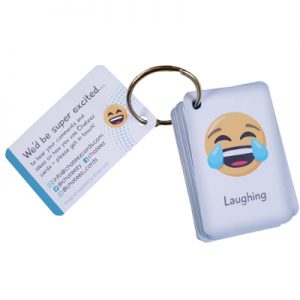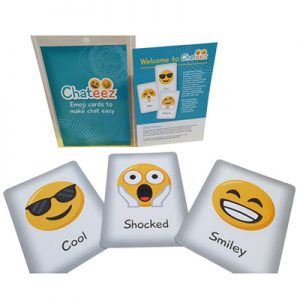
Resources
The activities set out below are ideas of how to use the  cards. Mix and match, adapt to find those activities that suit the needs of the children and young people you are working with. There are examples of how to use in both group and 1:2:1 settings.
cards. Mix and match, adapt to find those activities that suit the needs of the children and young people you are working with. There are examples of how to use in both group and 1:2:1 settings.
 Free Stuff
Free Stuff
-
Chateez wordsearchContent to follow
-
Chateez SudukoClick to download
-
Design your own ChateezContent to follow
-
Chateez note sheetContent to follow
 Ideas of how to use
Ideas of how to use
-
Act OutIn pairs or teams, have a person pick a card to ‘act out’. Their partner or teammates should guess the emotion and then have a conversation about it.
-
Check In and Check OutAt the start of a session, choose a cards to ‘check in’ with the group or individual about how they are feeling. Then open up the discussion to how they are feeling. This exercise can also be used to ‘check out’ at the end of the session.
-
ReflectionsChoose a card and use it to encourage young people to reflect on their feelings, personal triggers and coping strategies for that particular emotion.
-
Why, why, whyPlace a selections of cards on the floor and ask young people to write different questions about the different Chateez cards – for examples, ‘Why do people get angry?’ Work with the young people to come up with answers to their questions – for example, ‘People may get angry because of something that’s happened to them, due to their hormones, or they may be suffering from mental-health issues.’
-
Rank me!Ask young people to choose all the Chateez feelings they are experiencing right now. They could select as few as three or as many as 15! Get them to rank them in order of how strong their different feelings are, then discuss this. It may be necessary to explain that it’s OK to experience a range of feelings at the same time, and that sometimes they can be conflicting.
-
Chateez notes worksheetUse our Chateez worksheet alongside your Chateez cards during a one-to-one session or group work activity to capture notes of what has been said.
Download (Click to download. Then check your browser’s downloads folder.)
-
Top ten games for primary aged children
- Lay the cards face down. Ask a pupil to choose one but not tell the class what it is. They have to make the face and the class should guess it.
- Give the pupils a set of Chateez cards and some Play-Doh. Ask them to make some of the faces with the Play-Doh.
- In pairs, ask one pupil to pick a Chateez card and tell their partner about a time they have felt that way.
- Set up the Chateez cards on the floor. Call out an emotion. Ask the pupils to toss a beanbag on to the emotion you called out.
- Place a negative-emotion card in front of a cuddly toy and ask the pupils to think about what they could say to the toy to make it feel better.
- Pick a simple sentence, such as “Let’s go to the shops”. Ask pupils to take turns choosing a card and repeating the sentence with the voice and expressions that correspond to that emotion.
- While reading a favourite book together, ask pupils to hold up Chateez cards that best represent the feelings of the characters.
- Ask the class to sort the Chateez cards into positive and negative emotions.
- Ask each pupil in turn to pick a Chateez card and act out that emotion.
- In small groups, ask pupils to find pictures from magazines relating to the feelings on the Chateez cards.
Check out our  cards today!
cards today!










